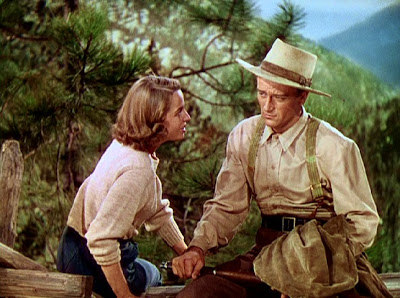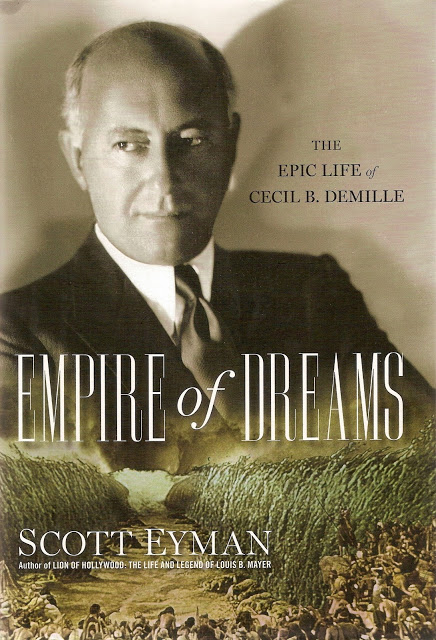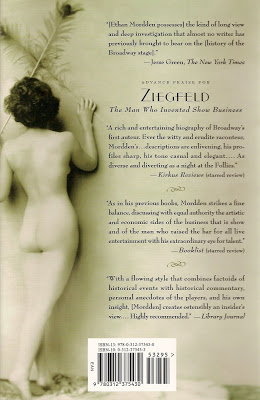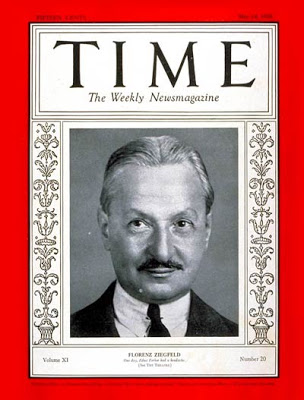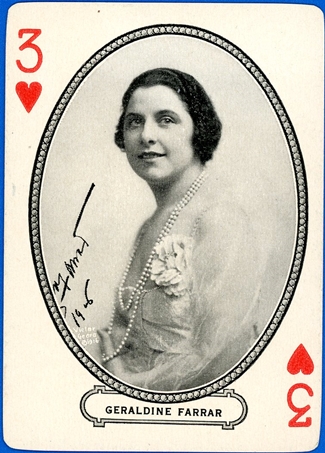
Geraldine Farrar was not the first star to occupy the M.J. Moriarty deck’s 3 of Hearts; that distinction (if Cliff Aliperti’s guess at the deck’s provenance is correct) belongs to Cleo Madison. But Ms. Farrar is the only Metropolitan Opera star in the deck. Other great singers would make the transition from Met to movies, but not until the sound era; and while some (Lawrence Tibbett, Grace Moore, Lily Pons, Maria Callas) would be more successful than others (Kirsten Flagstad, Luciano Pavarotti), only Geraldine Farrar managed to become a movie star without ever once depending upon her voice to get her there.
No wonder. She was a natural actress without a trace of self-consciousness, and the camera loved loved loved her. The picture on the card isn’t the most flattering, with that hairstyle like a leather aviator’s helmet, but you can see what I mean, especially with those enormous, all-seeing eyes — they make you want to glance over your right shoulder to see what she finds so fascinating and amusing; not even that huge corsage can pull your attention away from her eyes for very long.
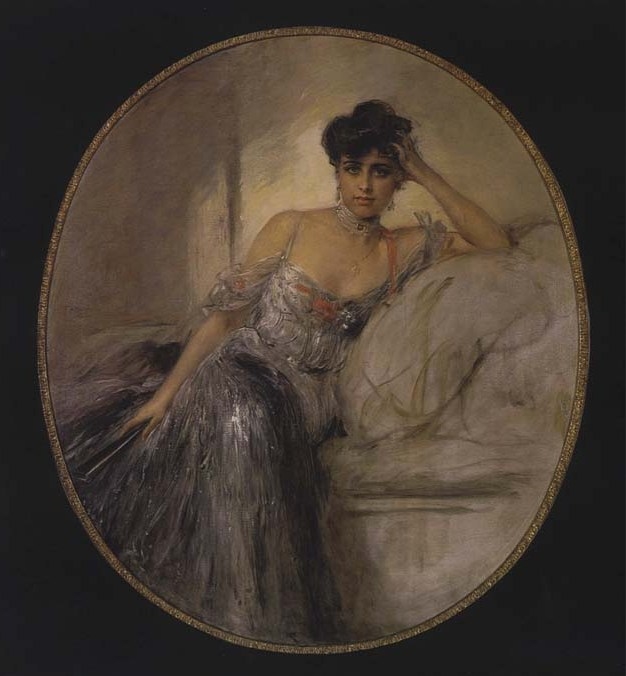 Here’s another look at those eyes, this time smoldering and looking straight into your own. The portrait is by the German painter Friedrich August von Kaulbach (1850-1920), and is now part of the Geraldine Farrar Collection in the Music Division of the Library of Congress. It was probably painted in late 1901 or early ’02, about the time the 19-year-old Geraldine created a sensation as Marguerite in Gounod’s Faust and became the toast of Berlin.
Here’s another look at those eyes, this time smoldering and looking straight into your own. The portrait is by the German painter Friedrich August von Kaulbach (1850-1920), and is now part of the Geraldine Farrar Collection in the Music Division of the Library of Congress. It was probably painted in late 1901 or early ’02, about the time the 19-year-old Geraldine created a sensation as Marguerite in Gounod’s Faust and became the toast of Berlin.And then, in 1915, yet another medium. Moving pictures came calling, in the form of Cecil B. DeMille and the Jesse L. Lasky Feature Play Company. Lasky and DeMille had been making a go of their venture out in sleepy Hollywood, shooting in a converted barn at the corner of Vine and Selma Streets. I don’t know what prompted them to approach Farrar; perhaps they read the interview where she described herself not as a singer but “an actress who happens to be appearing in opera” and figured an actress in any other vehicle… Whatever the impetus, it was a masterstroke. Farrar agreed to work eight weeks during the Met’s off season, making three pictures for a fee of $35,000. The news, and the announcement that the diva’s first picture would be a silent version of her Met success Carmen, electrified the industry. The William Fox Co. was inspired to do a quickie knockoff Carmen with their house vamp Theda Bara (Fox’s picture went into release the day after DeMille’s Carmen but doesn’t seem to have cut very deeply into its business).
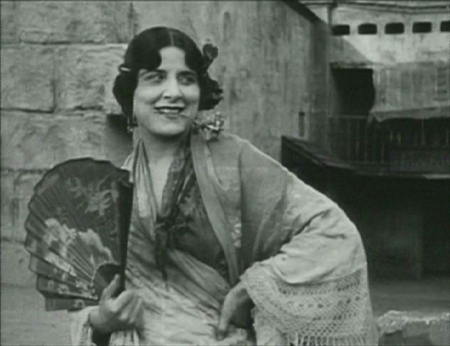
The DeMille-Lasky Carmen wasn’t planned as an adaptation of the opera; the work was still under copyright, and the proprietors were asking too much for the movie rights. Instead, DeMille and his scriptwriter brother William turned to Prosper Mérimée’s original novella, now in the public domain, which had a story much changed in the opera. Still, the opera was too familiar to ignore completely, so a musical score was commissioned adapting Bizet’s themes (Lasky could afford that much).
Before shooting on their big-money title, though, DeMille made a canny decision: he would shoot Farrar’s other two pictures (Temptation and Maria Rosa) first, just in case his leading lady needed a little experience to put her at ease in front of the camera. This was probably prudent, but it proved to be unnecessary; Geraldine Farrar took to movies like a duck to water. Here she is in Carmen’s classic pose — a cliché by now, but at that time you could hardly get away with leaving it out — the rose clenched in her teeth, lasciviously eying the unfortunate Don Jose (Wallace Reid), whom she intends to seduce to help her smuggler cohorts.
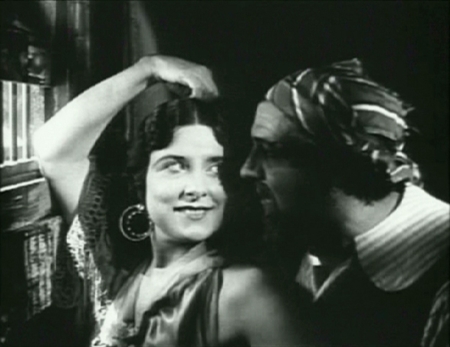 And here she is again, assuring her gypsy confederate (Horace B. Carpenter) that the trap is ready to be sprung. As DeMille biographer Scott Eyman observes, Farrar wasn’t exactly beautiful, but she was alluring. Her Carmen moves like a cat, slinky, self-assured and radiating a confident, even aggressive sexuality. (Apparently in real life, too; Crown Prince Wilhelm wasn’t the only name linked romantically with hers. While at the Met she carried on a torrid six-year affair with conductor Arturo Toscanini that ended only when she gave him an ultimatum: leave your wife or else. The maestro abruptly resigned from the Met and beat a hasty retreat back to Italy, wife and family in tow.)
And here she is again, assuring her gypsy confederate (Horace B. Carpenter) that the trap is ready to be sprung. As DeMille biographer Scott Eyman observes, Farrar wasn’t exactly beautiful, but she was alluring. Her Carmen moves like a cat, slinky, self-assured and radiating a confident, even aggressive sexuality. (Apparently in real life, too; Crown Prince Wilhelm wasn’t the only name linked romantically with hers. While at the Met she carried on a torrid six-year affair with conductor Arturo Toscanini that ended only when she gave him an ultimatum: leave your wife or else. The maestro abruptly resigned from the Met and beat a hasty retreat back to Italy, wife and family in tow.)
Carmen was a big hit for the Lasky Co., in both money and prestige. Not since the aging Sarah Bernhardt hobbled around on her wooden leg in Queen Elizabeth had a star of such international magnitude graced a movie screen. And it must be said, whatever the Great Sarah’s power on stage, she had hardly a tenth of Farrar’s instinctive understanding of movie acting. By the time the picture was released — on October 31, 1915 — Farrar had returned to the Met; the other pictures she had shot that summer were spaced out for release the rest of the season, Temptation at the end of December and Maria Rosa at the beginning of May 1916.
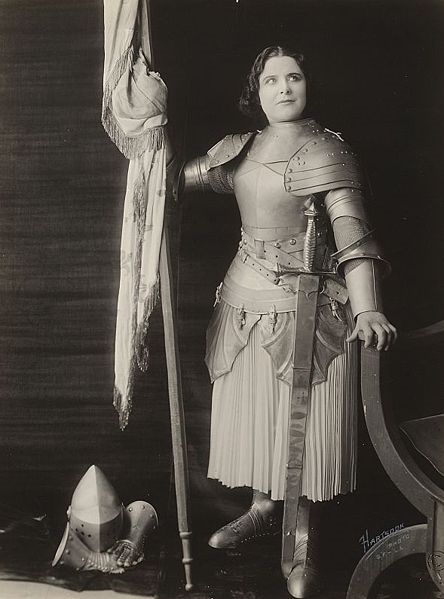 The Woman God Forgot wasn’t released until 1917; the big money picture for ’16 was Joan the Woman. DeMille and Macpherson drew a direct parallel between the Hundred Years War and the war then raging in Europe, telling the story of Joan’s battle for France within a framing story of an English officer in the trenches of the Great War (also played by Wallace Reid) who takes heart from Joan’s devotion (and attains a similar shall-not-have-died-in-vain martyrdom under the barbed wire). This publicity still was presumably approved for release by DeMille and Lasky, but unfortunately it isn’t terribly becoming to Ms. Farrar; granted, she was some years over-age (and some pounds overweight) for the role, but in the finished picture she never looks quite as tomboy-silly as she does here.
The Woman God Forgot wasn’t released until 1917; the big money picture for ’16 was Joan the Woman. DeMille and Macpherson drew a direct parallel between the Hundred Years War and the war then raging in Europe, telling the story of Joan’s battle for France within a framing story of an English officer in the trenches of the Great War (also played by Wallace Reid) who takes heart from Joan’s devotion (and attains a similar shall-not-have-died-in-vain martyrdom under the barbed wire). This publicity still was presumably approved for release by DeMille and Lasky, but unfortunately it isn’t terribly becoming to Ms. Farrar; granted, she was some years over-age (and some pounds overweight) for the role, but in the finished picture she never looks quite as tomboy-silly as she does here.In fact, it was in working on Joan the Woman that Farrar demonstrated the quality that DeMille, throughout his career, would especially prize among his actors: absolute fearlessness. Well, not absolute; she was actually afraid of horses and had to be doubled in many of her riding scenes. But fearless nevertheless; you can see it in the battle scenes, as she strides resolutely in full armor (only without that dear little pleated skirt) among the flailing swords, maces and pikestaffs.
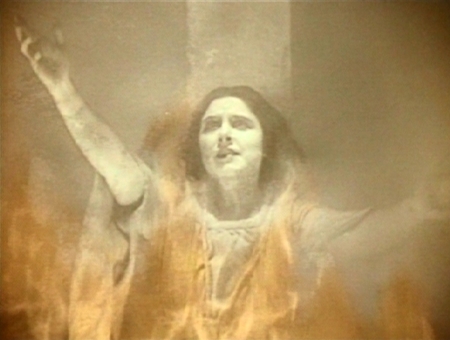
You can particularly see it in the scene of Joan’s execution at the stake, one of the most horrific scenes of the silent era, all the more effective for the stencil-tinting process that colored the flames of her pyre. Looking at a single frame, this closeup might look easy to fake, and it probably would be, but believe me, the flames in action look a lot closer and more dangerous than they do here. But if this shot of Joan appealing to her saints at the moment of death doesn’t convince you Geraldine Farrar was a real game ‘un…
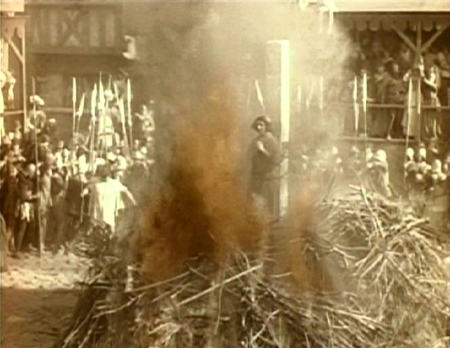
…then how about this?…
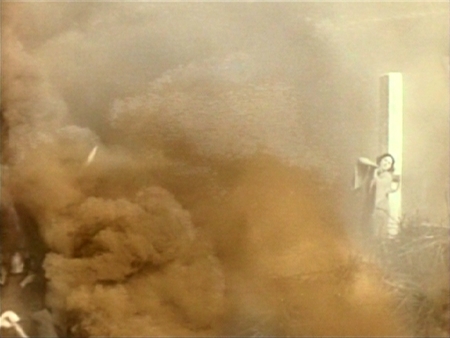
…or this?
As Scott Eyman says, “How Farrar managed to survive without third degree burns or, at the very least, smoke inhalation remains a mystery.”
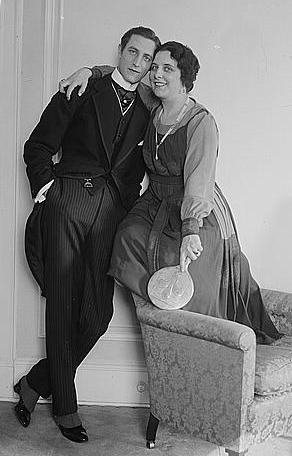 Alas, the honeymoon with Lasky and DeMille did not last, chiefly because of the honeymoon with Lou Tellegen. The Dutch-born Tellegen had come to America in 1910 at 29, as leading man (and offstage consort) to Sarah Bernhardt. After marrying Farrar in 1916, when she returned to Hollywood he began throwing his weight around and interfering in her films. To keep him out of their hair (and hers), DeMille and Lasky allowed him to direct a picture, What Money Can’t Buy. When they judged that one to be a dog — along with another, The Things We Love — Tellegen got his nose bent out of shape, and Farrar (out of what she later ruefully called “wifely loyalty”) sided with him. Both of them left the Lasky Co. and signed with Samuel Goldwyn.
Alas, the honeymoon with Lasky and DeMille did not last, chiefly because of the honeymoon with Lou Tellegen. The Dutch-born Tellegen had come to America in 1910 at 29, as leading man (and offstage consort) to Sarah Bernhardt. After marrying Farrar in 1916, when she returned to Hollywood he began throwing his weight around and interfering in her films. To keep him out of their hair (and hers), DeMille and Lasky allowed him to direct a picture, What Money Can’t Buy. When they judged that one to be a dog — along with another, The Things We Love — Tellegen got his nose bent out of shape, and Farrar (out of what she later ruefully called “wifely loyalty”) sided with him. Both of them left the Lasky Co. and signed with Samuel Goldwyn.
Working her customary off-season shifts, Farrar made six pictures for Goldwyn (three co-starring Tellegen). When Goldwyn complained that her pictures were not doing well, she suggested (with no hard feelings) that they cancel the remaining two years of her contract. She left movies for good in 1920, though she appears to have remained in the M.J. Moriarty deck until it ceased production — perhaps in the hope that she might return to the screen; anyhow, it was back to the Metropolitan Opera, where she retired amid great fanfare in 1922 at the age of 40.
The marriage to Lou Tellegen (her only one, the second of four for him) suffered from his chronic infidelities and succumbed to divorce in 1923. Tellegen himself came to a sorry end in 1934, a month short of his 53rd birthday. By then he had lost his looks (to a combination of age and facial injuries in a fire) and his career. He was ailing (it was cancer, but he wasn’t told). In 1931 he had published an autobiography, Women Have Been Kind, essentially a long boast about his sexual conquests that made him widely despised as a kiss-and-tell cad. (That year, the old Vanity Fair magazine had spotlighted him in their monthly “Nominated for Oblivion” feature, referring to his memoir as Women Have Been Kind [of Dumb].) Now, three years later, he elected himself to the oblivion Vanity Fair had nominated him for: While visiting friends in Hollywood, he locked himself in the bathroom, stood naked before the mirror, stabbed himself seven times with a pair of sewing scissors, and bled to death over an array of his clippings he had strewn on the floor. Approached by a reporter for a comment, Geraldine Farrar said, “Why should that interest me?”
 What might have been if Geraldine Farrar had not joined in Lou Tellegen’s falling-out with Cecil B. DeMille is a tantalizing question mark. Even more tantalizing is the thought of how her career might have gone if she’d been born 20 years later, if she had made that hit in Berlin in 1921 instead of 1901. Then, when Hollywood went ransacking New York for musical talent during the sound revolution, she would have been about the age she is here, when she created the role of the Goose-Girl in Humperdinck’s Königskinder (The King’s Children) at the Met in 1910. Jeanette MacDonald and Irene Dunne, among others, may have had reason to be grateful that they never had to deal with any competition frrom Geraldine Farrar.
What might have been if Geraldine Farrar had not joined in Lou Tellegen’s falling-out with Cecil B. DeMille is a tantalizing question mark. Even more tantalizing is the thought of how her career might have gone if she’d been born 20 years later, if she had made that hit in Berlin in 1921 instead of 1901. Then, when Hollywood went ransacking New York for musical talent during the sound revolution, she would have been about the age she is here, when she created the role of the Goose-Girl in Humperdinck’s Königskinder (The King’s Children) at the Met in 1910. Jeanette MacDonald and Irene Dunne, among others, may have had reason to be grateful that they never had to deal with any competition frrom Geraldine Farrar.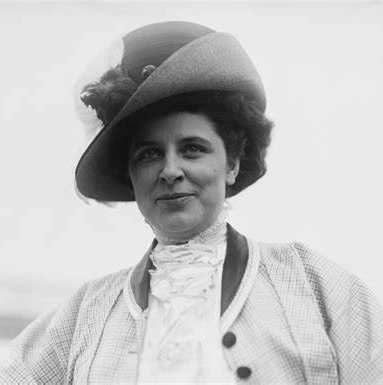

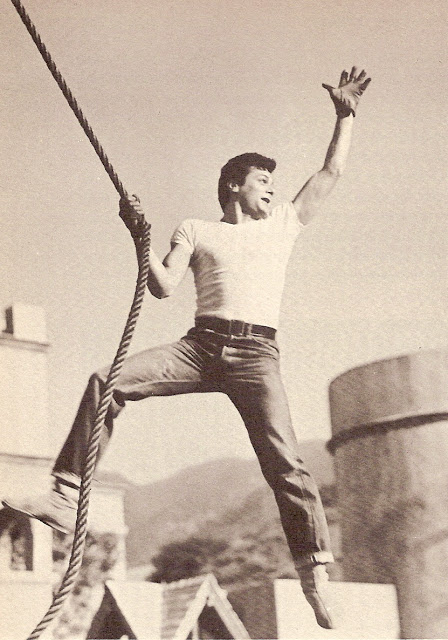
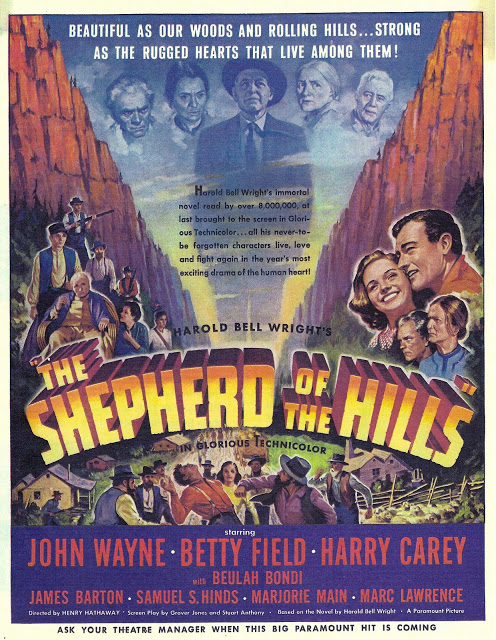
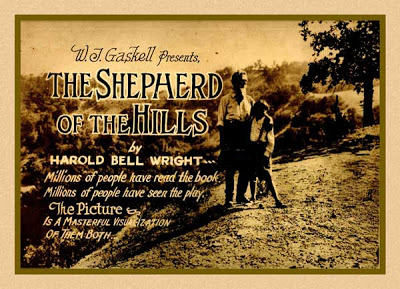
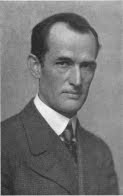
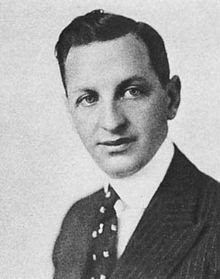
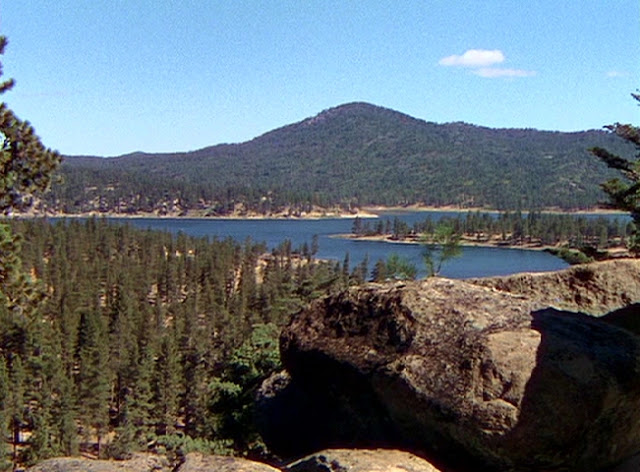
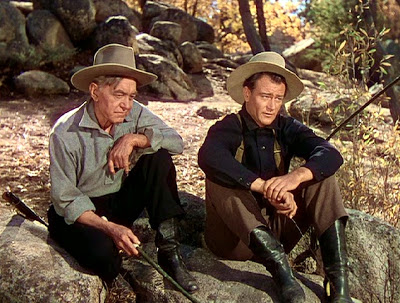
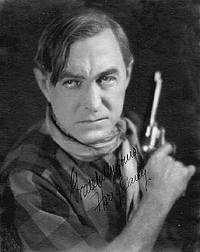
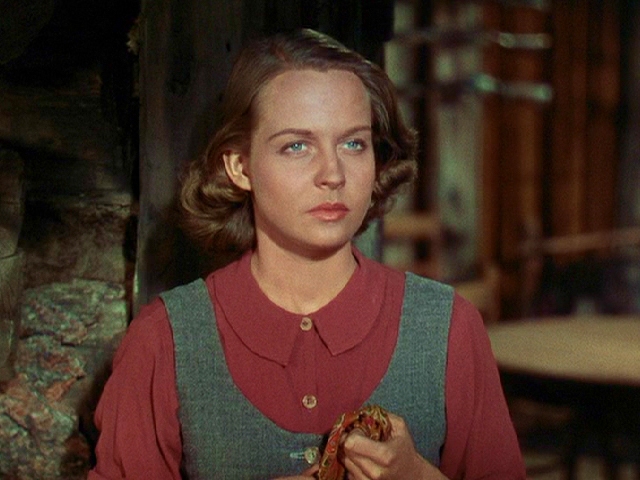
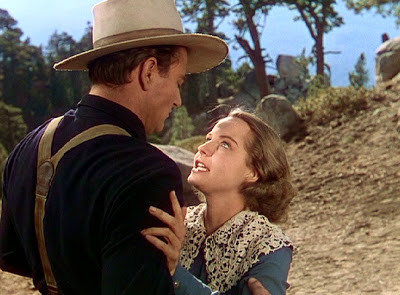 The best of the lot just may be Betty Field in Shepherd. Her Sammy is feisty and independent, uneducated and superstitious — muttering half-heard incantations, drawing symbols and spitting in the dirt before venturing into Moaning Meadow — but no fool. She knows her own world inside out, and when her moonshiner father stumbles home with a revenuer’s bullet in his side, she calmly goes about her business, slicing bacon and singing as if nothing had happened, until the suspicious lawmen have gone their way. When she meets Daniel Howitt, she’s wary at first, but she soon sees the good in the man and vouches for him to others; when he seeks to cash a check for the unheard-of sum of a hundred dollars, the storekeeper blanches, but says, “Sammy’s say-so is all right with me. I’ll look around.” Sammy senses the tender heart of Young Matt, too, and struggles to reach it, battering in futile frustration at the crust of hatred so carefully planted and tended by the malicious Aunt Mollie.
The best of the lot just may be Betty Field in Shepherd. Her Sammy is feisty and independent, uneducated and superstitious — muttering half-heard incantations, drawing symbols and spitting in the dirt before venturing into Moaning Meadow — but no fool. She knows her own world inside out, and when her moonshiner father stumbles home with a revenuer’s bullet in his side, she calmly goes about her business, slicing bacon and singing as if nothing had happened, until the suspicious lawmen have gone their way. When she meets Daniel Howitt, she’s wary at first, but she soon sees the good in the man and vouches for him to others; when he seeks to cash a check for the unheard-of sum of a hundred dollars, the storekeeper blanches, but says, “Sammy’s say-so is all right with me. I’ll look around.” Sammy senses the tender heart of Young Matt, too, and struggles to reach it, battering in futile frustration at the crust of hatred so carefully planted and tended by the malicious Aunt Mollie.
